check engine GMC YUKON HYBRID 2010 User Guide
[x] Cancel search | Manufacturer: GMC, Model Year: 2010, Model line: YUKON HYBRID, Model: GMC YUKON HYBRID 2010Pages: 120, PDF Size: 1.03 MB
Page 69 of 120
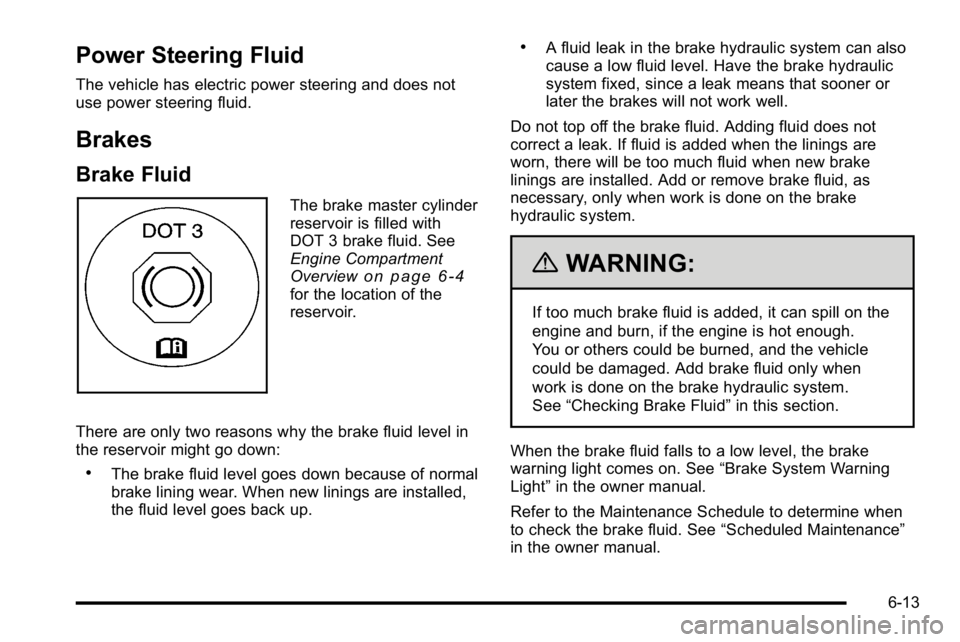
Power Steering Fluid
The vehicle has electric power steering and does not
use power steering fluid.
Brakes
Brake Fluid
The brake master cylinder
reservoir is filled with
DOT 3 brake fluid. See
Engine Compartment
Overview
on page 6‑4for the location of the
reservoir.
There are only two reasons why the brake fluid level in
the reservoir might go down:
.The brake fluid level goes down because of normal
brake lining wear. When new linings are installed,
the fluid level goes back up.
.A fluid leak in the brake hydraulic system can also
cause a low fluid level. Have the brake hydraulic
system fixed, since a leak means that sooner or
later the brakes will not work well.
Do not top off the brake fluid. Adding fluid does not
correct a leak. If fluid is added when the linings are
worn, there will be too much fluid when new brake
linings are installed. Add or remove brake fluid, as
necessary, only when work is done on the brake
hydraulic system.
{WARNING:
If too much brake fluid is added, it can spill on the
engine and burn, if the engine is hot enough.
You or others could be burned, and the vehicle
could be damaged. Add brake fluid only when
work is done on the brake hydraulic system.
See “Checking Brake Fluid” in this section.
When the brake fluid falls to a low level, the brake
warning light comes on. See “Brake System Warning
Light” in the owner manual.
Refer to the Maintenance Schedule to determine when
to check the brake fluid. See “Scheduled Maintenance”
in the owner manual.
6-13
Page 70 of 120
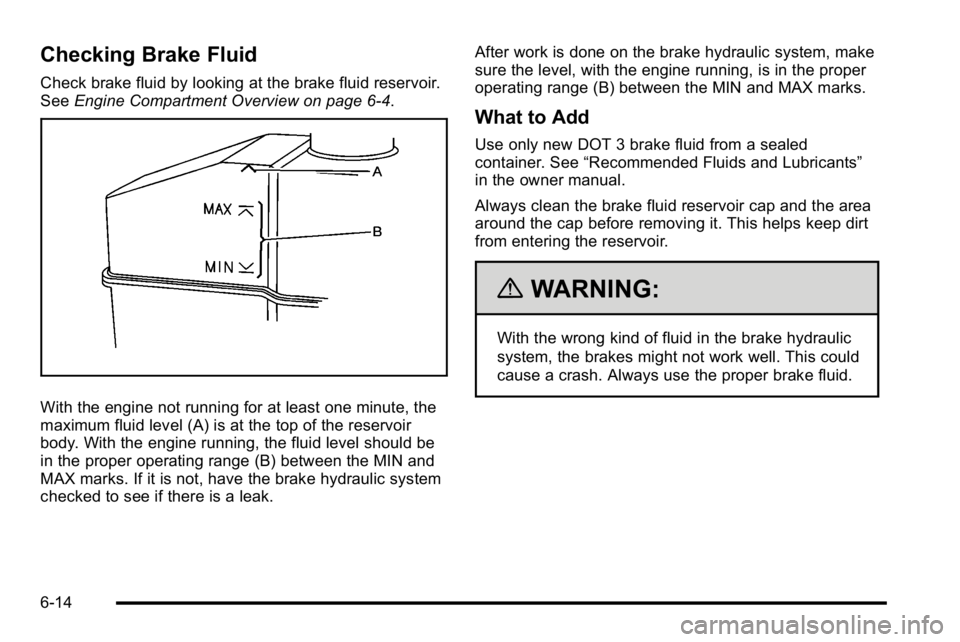
Checking Brake Fluid
Check brake fluid by looking at the brake fluid reservoir.
SeeEngine Compartment Overview on page 6‑4.
With the engine not running for at least one minute, the
maximum fluid level (A) is at the top of the reservoir
body. With the engine running, the fluid level should be
in the proper operating range (B) between the MIN and
MAX marks. If it is not, have the brake hydraulic system
checked to see if there is a leak. After work is done on the brake hydraulic system, make
sure the level, with the engine running, is in the proper
operating range (B) between the MIN and MAX marks.
What to Add
Use only new DOT 3 brake fluid from a sealed
container. See
“Recommended Fluids and Lubricants”
in the owner manual.
Always clean the brake fluid reservoir cap and the area
around the cap before removing it. This helps keep dirt
from entering the reservoir.
{WARNING:
With the wrong kind of fluid in the brake hydraulic
system, the brakes might not work well. This could
cause a crash. Always use the proper brake fluid.
6-14
Page 77 of 120
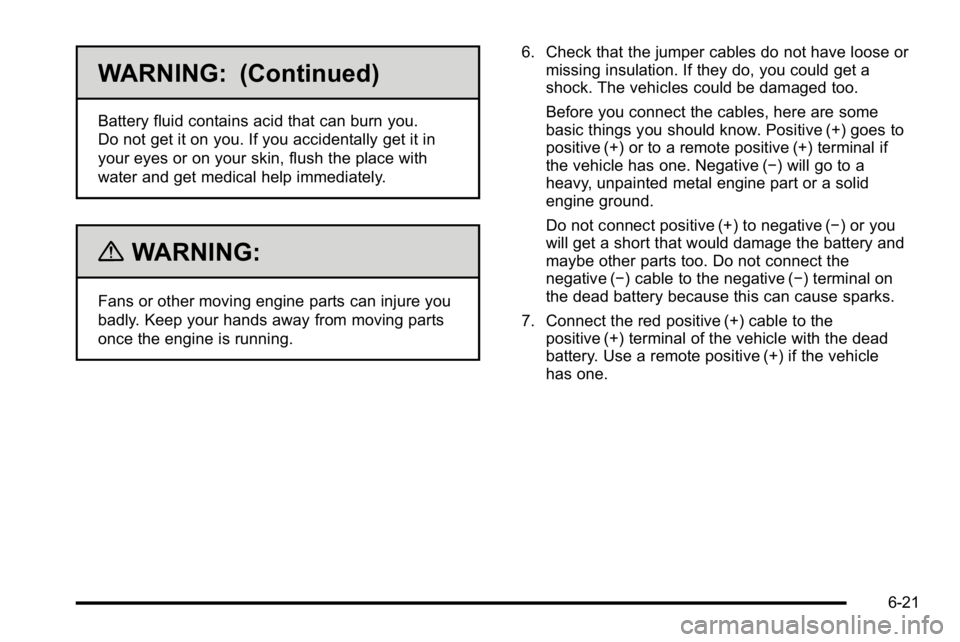
WARNING: (Continued)
Battery fluid contains acid that can burn you.
Do not get it on you. If you accidentally get it in
your eyes or on your skin, flush the place with
water and get medical help immediately.
{WARNING:
Fans or other moving engine parts can injure you
badly. Keep your hands away from moving parts
once the engine is running.6. Check that the jumper cables do not have loose or
missing insulation. If they do, you could get a
shock. The vehicles could be damaged too.
Before you connect the cables, here are some
basic things you should know. Positive (+) goes to
positive (+) or to a remote positive (+) terminal if
the vehicle has one. Negative (−) will go to a
heavy, unpainted metal engine part or a solid
engine ground.
Do not connect positive (+) to negative (−) or you
will get a short that would damage the battery and
maybe other parts too. Do not connect the
negative (−) cable to the negative (−) terminal on
the dead battery because this can cause sparks.
7. Connect the red positive (+) cable to the positive (+) terminal of the vehicle with the dead
battery. Use a remote positive (+) if the vehicle
has one.
6-21
Page 113 of 120
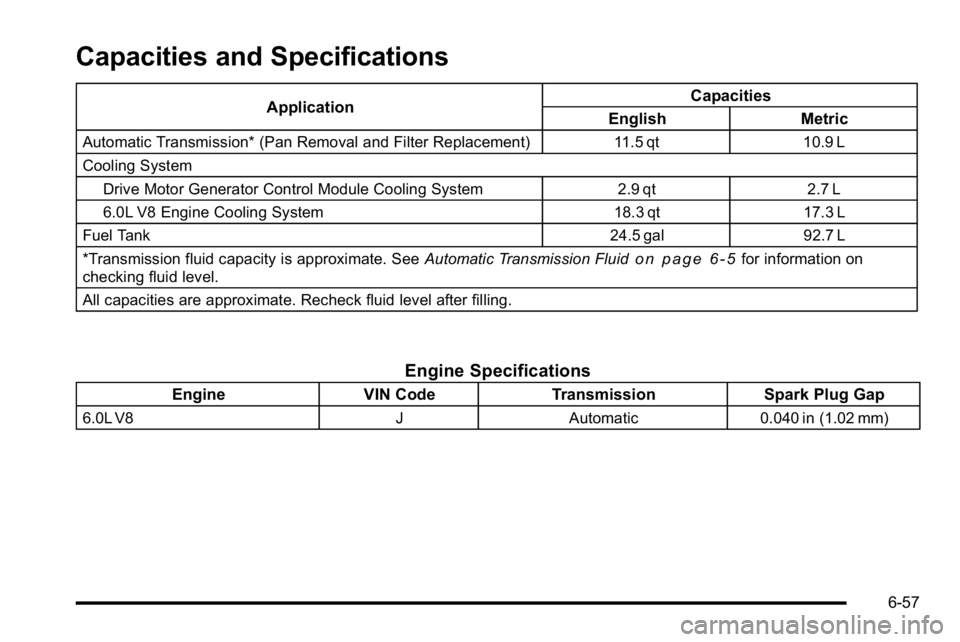
Capacities and Specifications
ApplicationCapacities
English Metric
Automatic Transmission* (Pan Removal and Filter Replacement) 11.5 qt10.9 L
Cooling System Drive Motor Generator Control Module Cooling System 2.9 qt2.7 L
6.0L V8 Engine Cooling System 18.3 qt17.3 L
Fuel Tank 24.5 gal92.7 L
*Transmission fluid capacity is approximate. See Automatic Transmission Fluid
on page 6‑5for information on
checking fluid level.
All capacities are approximate. Recheck fluid level after filling.
Engine Specifications
Engine VIN CodeTransmission Spark Plug Gap
6.0L V8 JAutomatic 0.040 in (1.02 mm)
6-57
Page 116 of 120
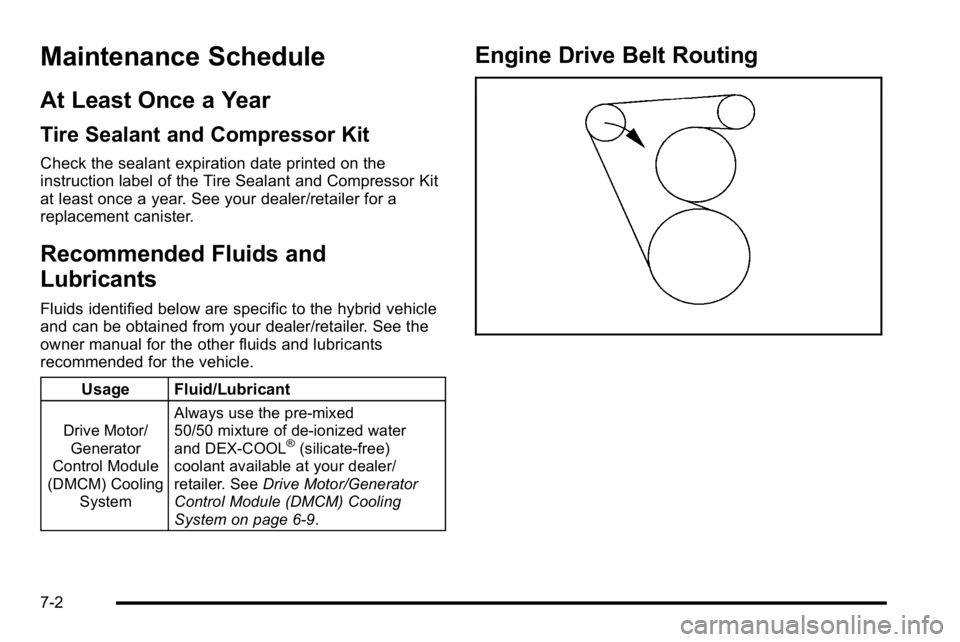
Maintenance Schedule
At Least Once a Year
Tire Sealant and Compressor Kit
Check the sealant expiration date printed on the
instruction label of the Tire Sealant and Compressor Kit
at least once a year. See your dealer/retailer for a
replacement canister.
Recommended Fluids and
Lubricants
Fluids identified below are specific to the hybrid vehicle
and can be obtained from your dealer/retailer. See the
owner manual for the other fluids and lubricants
recommended for the vehicle.Usage Fluid/Lubricant
Drive Motor/Generator
Control Module
(DMCM) Cooling
System Always use the pre-mixed
50/50 mixture of de‐ionized water
and DEX-COOL®(silicate-free)
coolant available at your dealer/
retailer. See Drive Motor/Generator
Control Module (DMCM) Cooling
System on page 6‑9.
Engine Drive Belt Routing
7-2